Difference between revisions of "The Sex Wars, 1970s to 1980s"
| Line 52: | Line 52: | ||
== Prominent Figures == | == Prominent Figures == | ||
| − | In “pro-sex” feminism, there existed many important figures, both within academia and without. One notable name within “pro-sex” feminism was Gayle Rubin. Though at the time she was not an academic, she is now a professor at the University of Michigan. She penned the extraordinarily piece, “Thinking Sex: Notes for a Radical Theory of the Politics of Sexuality.” This is considered to be one of the major theoretical cornerstones of “pro-sex” feminism. In it, Rubin puts forth a mountain of information about the politics of sexuality, including various sex panics throughout American history, ideological hurdles that impede people from developing a radical theory of sexuality, and how our society categorizes certain types of sexuality as “good” and others as “bad.” She also provides an intense critique of feminism, including the anti-pornography movement. She characterizes sex liberation as a feminist goal and repudiates the idea that the anti-pornography movement speaks for all of feminism.<ref>Gayle S. Rubin, “Thinking Sex: Notes for a Radical Theory of the Politics of Sexuality." In ''Social Perspectives in Lesbian and Gay Studies'', edited by Peter M. Nardi and Beth E. Schneider, 100- 133. New York City: Routledge, 1998, p. 122.</ref> Rubin concludes with the idea that drives her article, that what is needed is a theory of sexuality that is distinct from feminism. | + | [[Image:Rubin.jpg|frame|left|Gayle Rubin.<ref>http://goingsomewhere.blogsome.com/wp-admin/images/gayle.jpg </ref>]]In “pro-sex” feminism, there existed many important figures, both within academia and without. One notable name within “pro-sex” feminism was Gayle Rubin. Though at the time she was not an academic, she is now a professor at the University of Michigan. She penned the extraordinarily piece, “Thinking Sex: Notes for a Radical Theory of the Politics of Sexuality.” This is considered to be one of the major theoretical cornerstones of “pro-sex” feminism. In it, Rubin puts forth a mountain of information about the politics of sexuality, including various sex panics throughout American history, ideological hurdles that impede people from developing a radical theory of sexuality, and how our society categorizes certain types of sexuality as “good” and others as “bad.” She also provides an intense critique of feminism, including the anti-pornography movement. She characterizes sex liberation as a feminist goal and repudiates the idea that the anti-pornography movement speaks for all of feminism.<ref>Gayle S. Rubin, “Thinking Sex: Notes for a Radical Theory of the Politics of Sexuality." In ''Social Perspectives in Lesbian and Gay Studies'', edited by Peter M. Nardi and Beth E. Schneider, 100- 133. New York City: Routledge, 1998, p. 122.</ref> Rubin concludes with the idea that drives her article, that what is needed is a theory of sexuality that is distinct from feminism. |
Pat Califia, now Patrick Califia, was another important person within the “pro-sex” movement. Along with Gayle Rubin, he was one of the founders of Samois, the first lesbian sadomasochism group. He was a huge proponent of sadomasochism, which had been denied by lesbian feminism, as it meant an inequality of power between sexual partners. Califia characterizes himself as a sexual outsider, fighting for the rights of various sexual minorities, and he calls for other to do the same.<ref>Pat Califia, “A Secret Side of Lesbian Sexuality.” In ''Sexual Revolution'', edited by Jeffrey Escoffier, 527-536. New York City: Thunder's Mouth Press, 2003. p. 535.</ref> Others who were heavily involved in “pro-sex” feminism included Ellen Willis, who penned one of the first public feminist responses to the anti-pornography movement.<ref>Willis, “Feminism, Morality, and Pornography.” In ''Powers of Desire: The Politics of Sexuality'', edited by Ann Snitow, Christine Stansell, and Sharon Thompsen, 460-467. New York City: Monthly Review, 1983. p. 460.</ref> and Esther Newton, who spoke out in favor of butch/femme dynamics in lesbian sexuality. | Pat Califia, now Patrick Califia, was another important person within the “pro-sex” movement. Along with Gayle Rubin, he was one of the founders of Samois, the first lesbian sadomasochism group. He was a huge proponent of sadomasochism, which had been denied by lesbian feminism, as it meant an inequality of power between sexual partners. Califia characterizes himself as a sexual outsider, fighting for the rights of various sexual minorities, and he calls for other to do the same.<ref>Pat Califia, “A Secret Side of Lesbian Sexuality.” In ''Sexual Revolution'', edited by Jeffrey Escoffier, 527-536. New York City: Thunder's Mouth Press, 2003. p. 535.</ref> Others who were heavily involved in “pro-sex” feminism included Ellen Willis, who penned one of the first public feminist responses to the anti-pornography movement.<ref>Willis, “Feminism, Morality, and Pornography.” In ''Powers of Desire: The Politics of Sexuality'', edited by Ann Snitow, Christine Stansell, and Sharon Thompsen, 460-467. New York City: Monthly Review, 1983. p. 460.</ref> and Esther Newton, who spoke out in favor of butch/femme dynamics in lesbian sexuality. | ||
Revision as of 16:45, 15 July 2008
By Andrew McBride
During the 1970s, much of the discourse in the feminist movement was dominated by discussions of lesbian feminism. Toward the end of the decade, however, the conversations within feminism began to focus on a new topic: sexuality. This included sexuality of all types, not just lesbian sexuality. Included in the discussions and debates were heterosexuality, pornography, sadomasochism, butch/femme roles, and sex work. One of the issues, that of pornography, was quickly taken up by some in the feminist movement as a central issue, and so the anti-pornography feminist movement was born. Very soon afterward, there was a reaction against this strain of thought, a reaction which is often termed “pro-sex” feminism. The two sides of this debate quickly became polarized, with each side shoring up its defenses against assaults from opponents. Thus were born the Sex Wars. With the arrival of the Sex Wars came many questions that still plague feminists and lesbians today. What is the fundamental nature of sex and sexuality? Is pornography an issue of violence against women or an issue of free speech? Which kinds of sex are appropriate and politically correct and which are not? Who gets to decide? How did each side of the debate characterize themselves and how were they characterized by their opponents? In what ways did the debates around sexuality affect lesbian women? How are people still being affected today?
Anti-Pornography Feminism
Lesbian Feminism and Anti-pornography
In the late 1970s, anti-pornography feminism began to develop out of certain corners of lesbian feminism. It drew on arguments of male sexuality and patriarchal sexual relations. Ellen Willis says that this includes the argument that “patriarchal sexual relations are based on male power backed by force” [1]. Therefore, because pornography is almost exclusively made by men and for men, it then reflects the dominant male paradigm surrounding sexual relations. This demonization of male sexuality that was evident in lesbian feminism became a powerful trope in many of the writings and theories of anti-pornography feminists. The dismissal of butch/femme relations as merely a caricature of heterosexuality was also adopted by anti-pornography feminism from lesbian feminism. The idea that sexuality is primarily about bonding and forming lasting relationships with another person was also taken from lesbian feminism[2]. It should be made noted, however, that, though anti-pornography feminism drew on certain aspects of lesbian feminism, they were not the same thing and cannot be conflated with each other. Pornography, though disparaged in lesbian feminism, was not a major focus of that movement.
Women Against Violence in Pornography and Media
In 1976, the group known as Women Against Violence in Pornography and Media, or WAVPM, was born. They were based in San Francisco and, as one of their first demonstrations, they led a six hundred woman march down one of the largest pornography strips in the city. They began to organize speaking engagements at a variety of venues, such as libraries, colleges, and women's apartments. One of their tactics at these events was to present a slide show of pornographic pictures to illustrate they types of images that they were fighting against[3]. The organization's stated goals were as follows:
- To educate woman and men about the woman-hatred expressed in pornography and other media violence to women, and to increase understanding of the destructive consequences of these images;
- To confront those responsible—for example, the owners of pornographic stores and theaters, those who devise violent images on record covers, newspapers that give a lot of space to advertising pornographic movies, politicians who give out permits for “live shows,” pornographic bookstores, etc.;
- To put an end to all portrayals of women being bound, raped, tortured, killed, or degraded for sexual stimulation or pleasure. We believe that the constant linking of sexuality and violence is dangerous.[4]
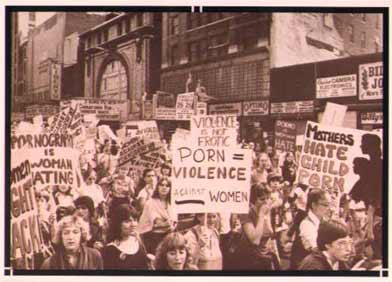
WAVPM objected to all pornography, even that which was not violent, on the argument that it all objectified the bodies of women. They proposed a direct link between pornography and men's violence against women. [6] They also characterized the proliferation of pornography at that time as a backlash against the feminist movement. This gave them all the more reason to fight against pornography. They eventually began to help organize chapters of Women Against Pornography (WAP) in other parts of the country, such as New York City, where they would conduct tours of Times Square sex shops.
Prominent Figures
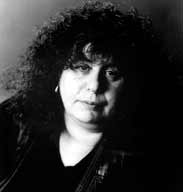
One of the most important people involved in the anti-pornography movement was Andrea Dworkin. A radical feminist, she quickly became known as one of the most outspoken critics of pornography within the anti-pornography movement. She first spoke of pornography in her book Woman Hating. She later expanded her arguments against pornography into an entire book, Pornography: Men Possessing Women. She characterized the theme of pornography to be male power and therefore extremely damaging to women.[8]. She spent the entire book going through countless examples of pornography, both historical and contemporary, from the Marquis de Sade to Penthouse. Her goal was to show how, in each and every instance, pornography is harmful to women and detrimental to their well-being. To Dworkin, pornography was not only harmful in its production, in that it harms the women who are performing, but it was also harmful in its consumption because men internalize the misogynistic portrayals of women in pornography. She equated pornography with violence and force and left little, if any, room for debate. She also spent a good amount of time in her book demonizing male sexuality, such as “[M]ale sexual aggression is the unifying thematic and behavioral reality of male sexuality”.[9] In the lines directly after this statement, she makes it clear that she does not differentiate in any way between heterosexual and homosexual men. Her points are well summed up in this quote:
Pornography is the essential sexuality of male power: of hate, of ownership, of hierarchy; of sadism, of dominance. The premises of pornography are controlling in every rape and every rape case, whenever a woman is battered or prostituted, in incest, including in incest that occurs before a child can even speak, and in murder—murders of women by husbands, lovers, and serial killers.[10]
In this sweeping statement, Dworkin basically asserts that pornography is the cause of every kind of violence against women, no matter how mundane or grotesque. Her rhetoric became standard in the anti-pornography movement and her invective became effective in further polarizing the issue.
Other prominent figures in the movement included Catherine MacKinnon, a constitutional lawyer who often worked closely with Dworkin. Others included Laura Lederer, Diana E.H. Russell, and Adrienne Rich, all of whom had a hand in creating either WAVPM or WAP.
“Pro-Sex” Feminism
The Basics
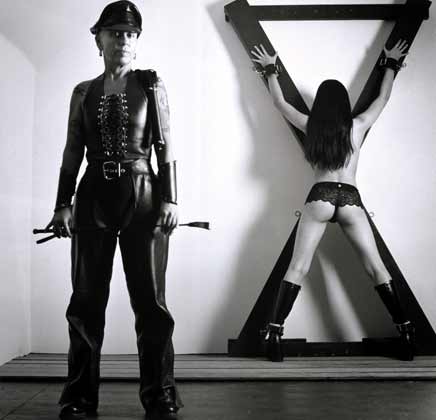
It is sometimes claimed that “pro-sex” feminism has its historical roots in such reformers of sexual morality as Havelock Ellis and Margaret Sanger (“Sex-Positive Feminism”). The modern “pro-sex” feminism, however, came about in the early 1980s. It was a direct reaction and response to the anti-pornography movement in feminism. Many within the feminist movement saw this as a move toward censorship and greater oppression of sexuality. Those who were considered to be part of “pro-sex” feminism thought sexual freedom to be paramount in the fight for the freedom of women and all other peoples. For “pro-sex” feminists, the patriarchal nature of our society does not merely oppress the sexuality of women, but of all people. In this fashion, they did not accept the demonization that was common among anti-pornography feminists (“Sex-Positive Feminism”). They were characterized by the “primacy of pleasure theory”, in that they theorized that sexuality is an exchange of physical and genital pleasure, as opposed to merely intimacy and bonding.[12] Because of all of these beliefs, they generally opposed obscenity laws and other measures that they saw as being restrictive of sexual expression.
Prominent Figures
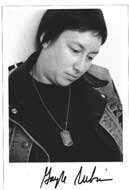
In “pro-sex” feminism, there existed many important figures, both within academia and without. One notable name within “pro-sex” feminism was Gayle Rubin. Though at the time she was not an academic, she is now a professor at the University of Michigan. She penned the extraordinarily piece, “Thinking Sex: Notes for a Radical Theory of the Politics of Sexuality.” This is considered to be one of the major theoretical cornerstones of “pro-sex” feminism. In it, Rubin puts forth a mountain of information about the politics of sexuality, including various sex panics throughout American history, ideological hurdles that impede people from developing a radical theory of sexuality, and how our society categorizes certain types of sexuality as “good” and others as “bad.” She also provides an intense critique of feminism, including the anti-pornography movement. She characterizes sex liberation as a feminist goal and repudiates the idea that the anti-pornography movement speaks for all of feminism.[14] Rubin concludes with the idea that drives her article, that what is needed is a theory of sexuality that is distinct from feminism.
Pat Califia, now Patrick Califia, was another important person within the “pro-sex” movement. Along with Gayle Rubin, he was one of the founders of Samois, the first lesbian sadomasochism group. He was a huge proponent of sadomasochism, which had been denied by lesbian feminism, as it meant an inequality of power between sexual partners. Califia characterizes himself as a sexual outsider, fighting for the rights of various sexual minorities, and he calls for other to do the same.[15] Others who were heavily involved in “pro-sex” feminism included Ellen Willis, who penned one of the first public feminist responses to the anti-pornography movement.[16] and Esther Newton, who spoke out in favor of butch/femme dynamics in lesbian sexuality.
Other Important Issues
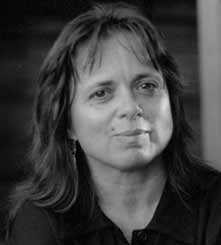
Other than pornography, which was the issue at the forefront for the anti-pornography movement, many issues were examined and taken up by “pro-sex” feminists. One such issue was that of sadomasochism. Part of the anti-pornography movement's legacy from lesbian feminism was the assertion that all correct sexuality must be between partners with equal amounts of the power in the matter. Sadomasochism repudiates this, stating that power exchanges can be erotic and fulfilling for both partners in the situation. It was characterized by some as healing for the parties involved, as catharsis.[18] Lesbian sadomasochists fought especially hard against those who repudiated sadomasochism. Another major issue was that of butch/femme roles. Once again, via lesbian feminism, the anti-pornography movement spoke against butch/femme roles, in that they saw them as being paltry farces of traditional heterosexual roles. Many lesbian reputed this notion and stated that butch/femme roles could in fact be considered as transgressive potentials for subverting heterosexual gender norms. [19] They are also extremely fulfilling and meaningful to the people who claim such identities.[20] These issues, among others, were prominent in the minds of those who identified as “pro-sex” feminists.
Conflicts and Criticisms
The Barnard Conference on Sexuality
When both sides of the Sex Wars came together, it was bound to become explosive. One of the most significant examples of this was the ninth conference in “The Scholar and the Feminist” series in 1982. The conference series was designed to bring together various feminist academics and feminist politics together. This particular event was held at Barnard and the organizing theme was to be Sexuality.[21] There was controversy surrounding the event from the beginning. Anti-pornography feminists were angered because they had been excluded from the conference's planning committee. The organizers justified this by claiming that the anti-pornography movement already dominated the American feminist discourse on sexuality. They contended that there was a very real possibility that, had they been allowed to participate in the planning, the anti-pornography viewpoint would have overrun everything else.[22] On the day of the conference, protesters positioned themselves outside of the building, not block people from entering, but to pass out information explaining their viewpoints. Both the plenary papers and the afternoon workshops proved to be controversial and were given by such diverse feminists as Alice Echols, Gayle Rubin, Esther Newton, Shirley Walton, Kate Millet, and Amber Hollibaugh.[23] The controversy extended past the end of the actual conference. The conference series lost its funding and the feminist magazine Off Our Backs provided "biased" reporting about the event.[24] Though it brought many of these issues to the fore, unfortunately one of the main achievements of the conference was to further harden the battle lines that had been drawn by each side during the Sex Wars.
Civil Rights Ordinances Concerning Pornography
One tactic that became particularly well-known during the Sex Wars was employed by the anti-pornography feminists, specifically Andrea Dworkin and Catherine MacKinnon. Together they attempted to pass an amendment to Minneapolis's civil rights law in 1983, namely one that would “recognize pornography as a violation of the civil rights of women, as a form of sex discrimination, an abuse of human rights.”[25] The ordinance would have allowed people harmed by pornography to sue for sex discrimination. They organized hearings in which women came forth in public to tell their stories of how they had been victimized by pornography. Though two city councils passed the law, the mayor vetoed it both times[26] Very similar laws were passed in Indianapolis, IN, Cambridge, MA, and Bellingham, WA. In each case, courts ended up overturning the statutes, ruling them unconstitutional.[27]. The development of this avenue of activism had an impact on a national level when both the Senate Judiciary Committee and the Attorney General's Commission on Pornography held public hearings on the effects of pornography on women and children.[28] These were also instances in which the anti-pornography movement aligned itself with the Christian right wing, even though the right wing has traditionally been inimical to the aims of the feminist movement.
Criticisms
Criticisms abounded during this time period for both sides of the Sex Wars. A major criticism levied at both sides was in the simplifying of the debate around sexuality. Both camps became dogmatic in their ideologies and refused to see the complexities and intricacies of the issues.[29] Another criticism was that both sides were working under rubrics of ahistoricity. While the anti-pornography feminists portrayed patriarchal dominance as a monolithic institution that never changed or was challenged, the “pro-sex” feminists did the same with ideas of sexual repression.[30] Wendy Chapkis points out that the two camps of feminism in the debate had diversities and debates within themselves and were not nearly as monolithic as they were assumed to be [31] Carole S. Vance and Ann Barr Snitow have put forth a number of criticisms of the anti-pornography movement. They allege that the concept of the social construction of sexuality has been misused. They also elaborate on the ways in which anti-pornography feminists have conflated certain issues together, such as pornography, sex, and violence, so that they all become the same thing.[32] They also raise questions of representations of sexuality and an unwillingness to explore areas of sexual difference. [33] Much of these criticisms connect around the idea that ideologies, especially when defined in opposition to other ideologies, become faulty and incomplete in themselves.
Conclusion
Looking at the Sex Wars provides us with a view of many of the fights and arguments that have complicated the feminist movement since the late 1970s. Both the anti-pornography movement and “pro-sex” feminism have raised a multitude of questions and problems that remain unanswered today. Though the debate was fractious and oftentimes vicious, there have been a number of positive outcomes. As Arlene Stein points out, many lesbians who do not necessarily describe themselves as “pro-sex” feminists are grateful for their existence, as they feel that room for discussions of lesbian sexuality has been expanded.[34] The debate also opened up new opportunities for coalition-building with gay men, which was especially important with the coming of the AIDS crisis.[35] Though the debate remains unresolved to this day, it did much to open new ground for exploration in the field of sexuality that still awaits us today.
- ↑ Ellen Willis, “Feminism, Morality, and Pornography.” In Powers of Desire: The Politics of Sexuality, edited by Ann Snitow, Christine Stansell, and Sharon Thompsen, 460-467. New York City: Monthly Review, 1983, p.464.
- ↑ Ann Ferguson, “Sex War: The Debate Between Radical and Libertarian Feminists.” Signs 10, no. 1 (Autumn 1984): 106-112, p. 108.
- ↑ Diana E.H. Russell and Laura Lederer, “Questions We Get Asked Most Often”, in Take Back the Night, edited by Laura Lederer, 23-29. New York City: William Morrow & Co, Inc., 1980, p. 23
- ↑ Russell and Lederer, “Questions We Get Asked Most Often”, p.24.
- ↑ http://www.jocelync.com/hvpress/images/antiporn_psd.jpg
- ↑ Russell and Lederer, “Questions We Get Asked Most Often”, p. 25.
- ↑ http://www.filmmakermagazine.com/blog/DWORKIN_ANDREA.jpg
- ↑ Andrea Dworkin, Pornography: Men Possessing Women. New York City: E.P. Dutton, 1979, p.24
- ↑ Dworkin, Pornography: Men Possessing Women. New York City: E.P. Dutton, 1979, p. 57.
- ↑ Dworkin, Pornography: Men Possessing Women, p. xxxix.
- ↑ http://sdholman.com/gallery/leatherdyke_calendar/3_G.
- ↑ Ferguson, “Sex War: The Debate Between Radical and Libertarian Feminists”, p. 109.
- ↑ http://goingsomewhere.blogsome.com/wp-admin/images/gayle.jpg
- ↑ Gayle S. Rubin, “Thinking Sex: Notes for a Radical Theory of the Politics of Sexuality." In Social Perspectives in Lesbian and Gay Studies, edited by Peter M. Nardi and Beth E. Schneider, 100- 133. New York City: Routledge, 1998, p. 122.
- ↑ Pat Califia, “A Secret Side of Lesbian Sexuality.” In Sexual Revolution, edited by Jeffrey Escoffier, 527-536. New York City: Thunder's Mouth Press, 2003. p. 535.
- ↑ Willis, “Feminism, Morality, and Pornography.” In Powers of Desire: The Politics of Sexuality, edited by Ann Snitow, Christine Stansell, and Sharon Thompsen, 460-467. New York City: Monthly Review, 1983. p. 460.
- ↑ http://www.queerculturalcenter.org/Media/QFest05Imgs/MoragaCherr.jpg.
- ↑ Califia, “A Secret Side of Lesbian Sexuality" p.534.
- ↑ Esther Newton “The Mythic Mannish Lesbian: Radclyffe Hall and the New Woman.” In Hidden from History, edited by Martin Duberman, Martha Vicinus, and George Chauncey, 281-293. New York City: Penguin Books Ltd., 1991, p.291.
- ↑ Amber Hollibaugh and Cherrie Moraga, “What We're Rollin' Around in Bed With.” In Sexual Revolution, edited by Jeffrey Escoffier, 538-552. New York City: Thunder's Mouth Press, 2003, p.545-546.
- ↑ Wilson, “The Context of 'Between Pleasure and Danger'" p.35.
- ↑ Wilson, “The Context of 'Between Pleasure and Danger'" p.35-36.
- ↑ Wilson, “The Context of 'Between Pleasure and Danger'", p. 37-39.
- ↑ Wilson, “The Context of 'Between Pleasure and Danger'" p.39-40.
- ↑ Dworkin, Pornography: Men Possessing Women p. xxviii.
- ↑ Dworkin, Pornography: Men Possessing Women p.xxx.
- ↑ Dworkin, Pornography: Men Possessing Women p. xxx-xxxi
- ↑ Dworkin, Pornography: Men Possessing Women p.xxxii.
- ↑ Ferguson, “Sex War: The Debate Between Radical and Libertarian Feminists.” p.110.
- ↑ Ilene Philipson, “The Repression of History and Gender: A Critical Perspective on the Feminist Sexuality Debate.” Signs 10, no. 1 (Autumn 1984): 113-118, p.113-114.
- ↑ Chapkis, “Chapter One: The Meaning of Sex.” In Live Sex Acts: Women Performing Erotic Labor, 11-32. New York City: Routledge, 1997. p. 12.
- ↑ Carole S. Vance and Ann Barr Snitow, “Toward a Conversation About Sex in Feminism: A Modest Proposal.” Signs 10, no. 1 (Autumn 1984): 126-135, p.129-130.
- ↑ Vance and Snitow, “Toward a Conversation About Sex in Feminism: A Modest Proposal”, p.131-134.
- ↑ Arlene Stein, “Sex, Kids, and Therapy: The Decentering of Lesbian Feminism.” In Sex and Sensibility: Stories of a Lesbian Generation, 123-153. Berkeley: University of California Press, 1997, p.143.
- ↑ Nancy E. Stoller, “Lesbian Involvement in the AIDS Epidemic: Changing Roles and Generational Differences.” In Social Perspectives in Lesbian and Gay Studies, edited by Peter M. Nardi and Beth E. Schneider, 366-376. New York City: Routledge, 1998, p. 374-375.